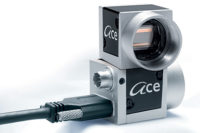
Source: James P. Hohner Jr.
This question pops up now and again, usually in the context of some discussion, blog post, or comparison of the various digital camera interfaces: GigE, USB, Camera Link, FireWire. However, experience with a wide variety of vision applications – ranging from machine vision and factory automation, to traffic systems and life sciences – and an understanding of what other digital interfaces have to offer, tells us that this is not the right question to ask when it comes to industrial imaging technology. The real question isn’t, “Is FireWire dying?”, but rather, “Does FireWire have a future as a relevant and viable technology for new vision applications?” While there is no single interface – no magic bullet – that addresses the unique needs of all applications, when compared to the existing lineup of digital interfaces FireWire offers some very unique features that make it well-suited for vision applications.
A wide variety of vision applications-ranging from machine vision and factory automation, to traffic systems and life science-and an understanding of what other digital interfaces have to offer, tells us that this is not the right question to ask when it comes to industrial imaging technology. The real question isn’t “Is FireWire dying?” but rather, “Does FireWire have a future as a relevant and viable technology for new vision applications?” While there is no single interface-no magic bullet-that addresses the unique needs of all applications, when compared to the existing lineup of digital interfaces FireWire offers some unique features that make it well-suited for vision applications.

Sales by Interface: Units
A Simple Example
To demonstrate the value of FireWire in vision applications consider the following example: a machine vision system inspects bottle cap tamper bands, which are used by manufacturers to guarantee bottled product quality and freshness. The system is conveyer-based, and uses four small analog “ice-cube” form-factor cameras that are mounted within a custom enclosure and controlled by a desktop computer located less than 10 meters away. To acquire a 360-degree image of the object, while maintaining a high inspection rate, multiple cameras are placed around the object. Images are acquired at the same time using an external trigger, delivered with very low latency to the host system, and finally processed by third-party vision software. The manufacturer wishes to replace the analog cameras with digital cameras without changing the enclosure. They also wish to minimize cabling and improve the system by increasing the frame rate at VGA resolution to 120 frames per second (fps).
Sales by Interface: Revenue
Guaranteed Bandwidth, Low-Latency Delivery and Synchronization
The IEEE 1394b standard (“FireWire-b” or “FireWire S800”) is the version most commonly used in industrial imaging applications. It provides raw data transfer rates of 1 Gbit/s, with data encoding dropping this down to 800 Mbit/s. The 1394b standard provides an isochronous transfer mechanism for video data that guarantees bandwidth. Isochronous transfers are scheduled by the bus so that they occur once every 125 microseconds (µs)-ideal for real-time “latency-critical” applications-without lost or delayed packets due to packet queuing.In the example above, FireWire’s data rates can easily accommodate two 0.3 megapixel cameras running at 120 fps, and adding another two cameras simply requires a second FireWire interface. While Gigabit Ethernet, at 1,000 Mbit/s, has enough bandwidth to do the same, it becomes more complex when more than one camera is used. In the case of FireWire, bandwidth management is achieved by communication with the isochronous resource manager on the bus. If the user attempts to transfer data from all four cameras at 120 fps simultaneously on the same interface, FireWire has automatic means of notifying the user application via the resource manager that this is not possible. There is no similar mechanism with GigE; in this example the cameras will simply stream as requested. Packet collisions will result and unless the camera and host drivers support a packet resend mechanism, data will be lost.
Bandwidth management is also much simpler under FireWire and is impacted by just two factors: packet size and transmission speed (e.g. S400 / S800). Bandwidth is also not typically impacted by the particular host controller being used. In comparison, bandwidth allocation in a GigE network is typically controlled using packet size and inter-packet delay, which in turn impact the frame transmission delay, bandwidth reserve, and bandwidth reserve allocation. GigE performance can vary depending on the network interface card (NIC) being used and whether Jumbo Packets are supported. To address these issues, most camera and software vendors provide mechanisms for easily managing bandwidth in GigE networks.
Low transport latency and the common isochronous time-base of the FireWire network can further be used to time-align frames and synchronize image exposure. Cameras with this “automatic synchronization” functionality are extremely useful in applications where external or software triggering is not practical or desirable for closely aligning-within 125 µs-the exposure of multiple cameras. Common industrial and machine vision applications of this functionality include using multiple cameras to acquire different views, or build a 3-D representation, of an object.
Power and Data over One Cable
FireWire is able to carry real-time video (1394 isochronous), control data (1394 asynchronous), and power over a single cable. The obvious advantage this brings is removing the requirement for additional cables and power supplies. This minimizes costs and potential points of failure. In contrast, some GigE and Camera Link cameras require a cable for power and another cable for video data, although those that support Power over Ethernet and Power over Camera Link. The suggested maximum cable length is 4.5 meters using shielded twisted pair (STP), but high-quality and relatively inexpensive 10 meter cables that still meet 1394’s electrical requirements are readily available. Cable shielding minimizes the impact of electromagnetic interference (EMI) on data transmission. Cables with screw lock connectors, 90-degree angle connectors, and high flex characteristics, are widely available and well-suited to industrial applications. 1394b allows more types of media, specifically glass optical fiber (GOF) up to 100 meters at any speed, 50 meters of plastic optical fiber, and 100 meters of unshielded twisted pair (UTP) Category 5 at 100 Mbits/s. Up to 15 hubs can be used to extend distance to 72 meters using STP.FireWire can provide up to 45 watts of power at 8 to 32 volts, which is significantly more than other digital interface, including USB 2.0 and USB 3.0 (2.5 watts and 4.5 watts, respectively), and Power over Ethernet (15 watts). Most compact digital cameras on the market today consume anywhere from 2 to 4 watts of power. The power delivery of FireWire enables more cameras to be powered by the bus rather than by external sources, which again minimizes cabling and cost.
Peer-to-Peer Network Architecture
At the heart of FireWire is a serial bus interface that supports device hot plugging (plug and play). Unlike other digital interfaces FireWire uses a more efficient peer-to-peer network architecture, in which the peripherals are intelligent and can negotiate bus conflicts to determine which device can best control a data transfer. Bus traffic may be sent directly to the node that requires data without routing through a host, meaning nodes on the bus e.g. cameras, can talk to each other.One unique feature of FireWire is its ability to broadcast asynchronous commands to other nodes on the bus. A practical application of this is the ability to broadcast a software trigger command simultaneously to all cameras on a single FireWire bus in order to synchronize image capture. Similarly, a set of properties such as video mode, frame rate, and exposure time, could be applied simultaneously to all cameras on a single FireWire bus.
A number of unique features inherent in the FireWire physical layer (PHY) are directly applicable to industrial applications. One such feature provides the central controller with complete visibility into the network topology, allowing it to map all the nodes (cameras) in the system, monitor the health of each node, and pinpoint error / failure points immediately. A PHY data packet can also be sent using a software command to disable a connected port, which yields similar results as unplugging the cable from the FireWire port. This minimizes the need to physically unplug a device, which can be troublesome in hard-to-reach locations.
FireWire also supports daisy-chaining, a unique feature that can be used to minimize components such as cables and hubs, and that can help create more robust “circular” networks. Using daisy-chaining, cameras equipped with two FireWire ports can be connected directly to each other. By stringing cameras together, a multi-camera network can easily be created with just a single FireWire connection on the PC side. No hubs are required and standard cables can be used. A circular network can be created by connecting both the “first” and “last” cameras in the chain to the same FireWire bus (assuming two ports on the interface card). The bus will remain stable and cameras will continue to operate regardless of whether any cable in the chain fails.

An up-close view of the inside of a machine vision setup. Source: Point Grey
Consumer and Industrial Adoption of FireWire
It is no secret that FireWire has seen a decline in consumer device support, particularly in laptop computers and consumer DVCs. However, adoption of FireWire for industrial applications remains strong and other industries, such as defense, are also realizing the benefits of FireWire.The recently published 2012 AIA Machine Vision Camera Study looks at the size and performance of the global machine vision camera market in 2011. The results are revealing. The market is large, annually worth approximately $612 million with no less than almost half a million (424,324) camera units sold. It grew at a healthy rate of 9.8% for revenue and 5% for units (from 406,408). In 2011, of the close to 500,000 cameras sold, almost one-third (31%) were FireWire, an increase of 3% over 2010. The increased size of the market and increase in the percentage of FireWire units sold translates to almost 18,000 more FireWire cameras sold in 2011 over 2010, for growth of over 15%. GigE camera unit sales, by comparison, grew less than 4% over 2010. These results suggest that while GigE continues to grow and gain market acceptance-at 30.3% of total unit sales it rivals FireWire-FireWire continues to be an interface of choice for many machine vision applications.
No Magic Bullet
Greater computing power, an increase in availability of high quality megapixel image sensors, advances in FPGA design and electronics miniaturization, and an overall decrease in component costs are opening new opportunities in machine vision. Customers, meanwhile, want more pixels at faster frame rates, superior reliability, and a migration path for future retrofits. Obviously if one interface can cover all requirements, ranging from size of the camera, bandwidth, cable length, price and so on, it would be the clear technical winner. But in reality customer requirements are too diverse to be met by just one interface.Selecting the right interface at the start can save a significant amount of time, resources and money, both during initial application development and for future projects. When compared to the other digital interfaces, a few of FireWire’s unique features help it stand out. It offers high data rates with guaranteed bandwidth and low latency, easy multiple camera support and synchronization, power and data over a single cable, and a peer-to-peer network architecture ideally suited to the demands of machine vision.V&S
Tech Tips
FireWire most commonly follows the IEEE 1394b standard for industrial imaging applications.It provides raw data transfer rates of 1 Gbit/s, with data encoding dropping this down to 800 Mbit/s.
Isochronous transfers are scheduled by the bus so that they occur once every 125 microseconds (µs).
FireWire’s data rates can easily accommodate two 0.3 megapixel cameras running at 120 fps.


